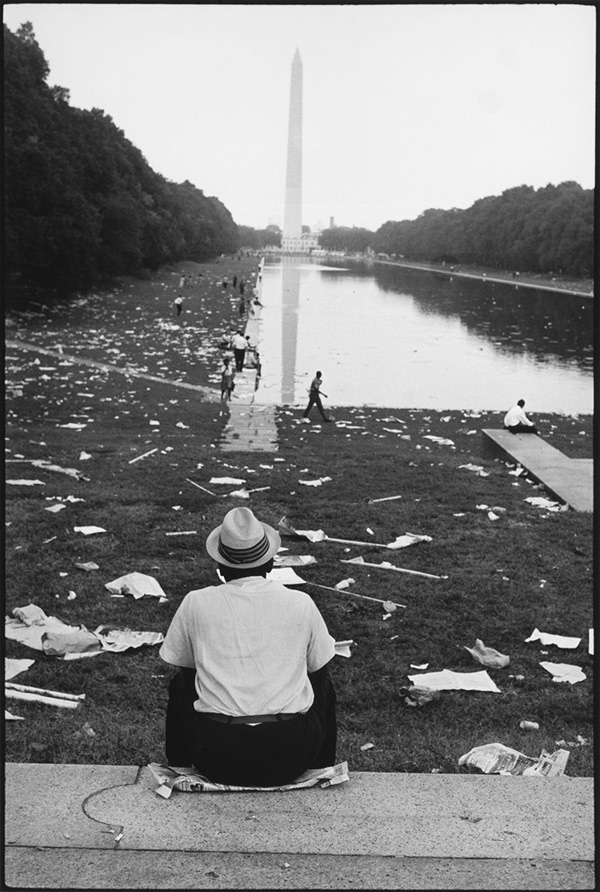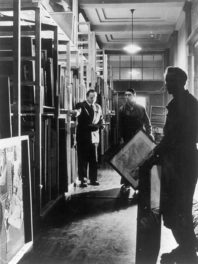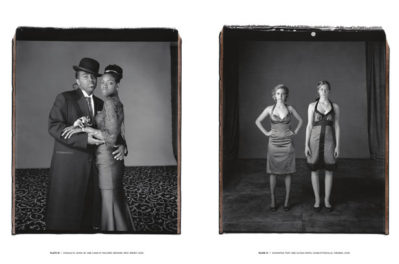
Leonard Freed, Untitled, from March on Washington series, 1963. © Estate of Leonard Freed-Magnum Photos (Brigitte Freed)
Throughout 2013, the Getty community participated in a rotation-curation experiment using the Getty Iris, Twitter, and Facebook. Each week a new staff member took the helm of our social media to chat with you directly and share a passion for a specific topic—from museum education to Renaissance art to web development. Getty Voices concluded in February 2014.
I’ve been passionate about civil rights since I was a child; so imagine my delight when Greg Britton, then publisher at Getty Publications, assigned me to a book project focusing on the August 28, 1963, March on Washington for Jobs and Freedom, the largest demonstration for civil rights ever held in America. Although I wasn’t able to be among the 250,000 marchers on that historic day—as I reveal in my poem “On This Day” in the video below—I would ultimately have the honor and privilege of helping to shape a moving photo-essay on the march by Magnum photographer Leonard Freed (American, 1929–2006). The resulting book, This Is the Day: The March on Washington, is closer to my heart than any project in my editorial career.
Every book begins with an idea, and usually an author. This one started with a stack of photographs in a cardboard box, presented to us one afternoon in 2010 by the photographer’s widow, Brigitte Freed. The prints she laid out on the table were images of men and women from across America, wearing their Sunday best, who had all converged at the nation’s capitol to call for racial equality. There were stirring close-ups of people singing their hearts out, long shots of a crowd so vast that distant faces became mere dots of light, images of small groups of people enraptured by the voice of the Rev. Dr. Martin Luther King, Jr., as he delivered his “I Have a Dream Speech” at the base of the Lincoln Memorial.

Leonard Freed, Untitled, from March on Washington series, 1963. © Estate of Leonard Freed-Magnum Photos (Brigitte Freed)
Brigitte told us that she was inspired to pull these images together in 2007, when she saw then-presidential hopeful Barack Obama on TV, speaking to an audience of civil rights activists in Selma, Alabama. “I’m here because you marched,” she recalled him saying, and immediately thought of her late husband’s photographs of the March on Washington. Leonard Freed had made those photographs as part of a larger photo-essay, published in 1967/68 as Black in White America (reissued by the Getty in 2010), but that book contained only a handful of the march photos. Now, with the 50th anniversary of that event approaching, this was the time to give them a book of their own.
My job, in part, would be to take these remarkable images and—working with the book’s designer, Jeffrey Cohen, and production coordinators Anita Keys and Amita Molloy—organize them for publication. Collaborating on the image sequencing with Brigitte Freed and Paul Farber, a scholar of Leonard Freed’s work, was a pure pleasure. Farber acted as the Getty’s liaison with Brigitte, wrote the afterward to the book, and completed his doctorate in American culture all at the same time.
An even greater challenge for me would be to engage the best author to convey the true significance of the march. One of the first names to come up was that of Farber’s mentor, Michael Eric Dyson, a sociology professor at Georgetown University and a noted author who had written more than 16 books, many of them on King’s life and work. I had recently heard Dyson interviewed on NPR. To say that I was impressed with his articulate brilliance would be an understatement. I was thrilled when he agreed write the essay.
A few months later, a good friend told me that Julian Bond, an important civil rights activist and a founder of the Student Nonviolent Coordinating Committee (SNCC), would be speaking in Los Angeles at an event organized by Zócalo Public Square. Bond had marched with King, and I was eager to meet him. Perhaps I could even ask him if he would be willing to write an endorsement for the back of the book.
After Bond’s inspiring talk, I inched my way into the enthusiastic throng, quickly introduced myself, and told him that the Getty was producing a book for the 50th anniversary of the march. No sooner did I utter those words than he graciously pulled out his business card and asked me to give him a call. When I wrote to him a few days later, I took a leap and, rather than asking him for a blurb, invited him to write the book’s foreword. He readily agreed and soon sent me a captivating behind-the-scenes look at the tense hours leading up to the march.
Although most of our book projects are copyedited by outside consultants, I didn’t want to let the work of these remarkable authors out of my hands. All that remained was to compile the remaining text. Dyson, who was much in demand with his own radio show, numerous TV appearances, and other engagements, sent me his essay with only weeks to spare. It showed up while I was preparing the Seder meal for Passover, the holiday that first sparked my awareness of what freedom really means. I found Dyson’s essay so profound and moving that I immediately read it aloud to my daughters while the matzo ball soup was still bubbling on the stove.
During one of my final editorial exchanges with Dyson by email, I mentioned that Ralph Eubanks, then director of publishing at the Library of Congress, had agreed to write a blurb for the back of the book. Dyson responded that he was in London, on his way to Paris with Jesse Jackson, and if I were interested he would ask the Rev. Jackson for an endorsement as well. I could hardly believe it, but lo and behold, when I arrived at my desk the next morning, there was an email with the Rev. Jackson’s poetic words awaiting me.
I may not have marched on August 28, 1963, but helping to bring This Is the Day into the world has given me a sense of purpose and joy as profound and humbling as if I had been singing with the marchers all along.

Leonard Freed, Untitled, from March on Washington series, 1963. © Estate of Leonard Freed-Magnum Photos (Brigitte Freed)




Dinah Berland’s post brought tears to my eyes. Her poem is beautiful!
Thanks so much. –Dinah
Dinah Berland’s beautiful poem brought me back to 1963 and Washington D.C. Her words of longing and joy echo magnificently for us all — what a gift!! Thank you!!
Thanks, Terry!
This is beautiful, Dinah! Thank you for sharing your stories.
Thank you, Moira!
Too young to remember this March, but as the sixities progressed we marched in Chicago, I knew friends who went to Jackson, Miss. for the times they were a’changin’ then just as now. This book is of major importance, so we not forget that equality needs to be fought for and does not come easy — let us use the power of these photos and the poetic words as example of hope for a better humanity.
Thank you, Janice,
Your experience and words are so important. They serve to remind us that art as well as social action can make a difference.
Best, Dinah
Dinah,
I loved hearing your poem. So special…what can I say!
Judith
Thanks so much, Judith!
Completely beautiful, Dinah. You shine a light on all that you think about and feel. Renee Geffen